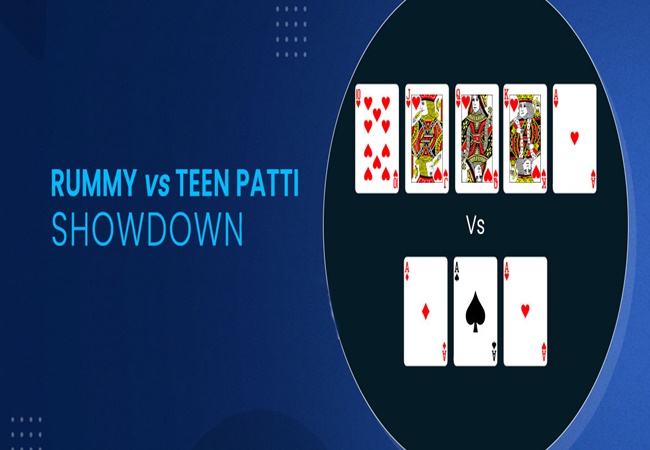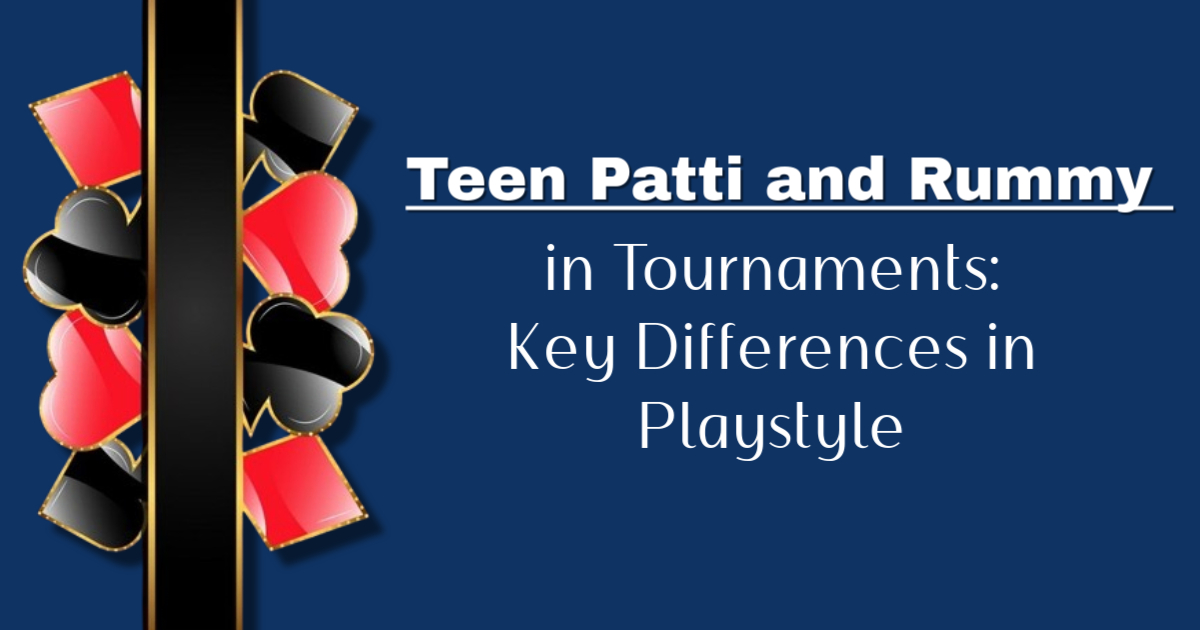Teen Patti and Rummy in Tournaments: Key Differences in Playstyle
Teen Patti and Rummy are two of the most popular card games in South Asia, with immense followings in India, Nepal, and other neighboring countries. Both games have their roots in traditional social gatherings but have grown to become staples of online gaming and competitive tournaments. Despite both being card games, Teen Patti and Rummy games differ widely in their gameplay mechanics, strategies, and tournament formats. Let’s explore the fundamental differences in how these games are approached in tournaments, highlighting their unique playstyles.

1. Objective of the Game: Luck vs. Skill
The most fundamental difference between Teen Patti Stars and Rummy lies in the game’s core objective and how luck and skill influence outcomes.
- Teen Patti is a game with a significant emphasis on chance, often likened to three-card poker. Players rely on the strength of their hands, but there’s also a strong element of bluffing and reading opponents. In tournaments, this reliance on luck can lead to highly volatile outcomes. Skilled players will have techniques to mitigate luck’s impact, such as carefully managing their bets and bluffing effectively, but ultimately the draw of the cards plays a massive role.
- Rummy is far more skill-based, especially in a tournament setting. Players focus on creating valid sets or sequences from their cards, requiring careful planning, memory, and strategy to track the cards drawn and discarded, especially in games like Teen Patti and Rummy. Success in Rummy tournaments depends heavily on pattern recognition and forward-thinking to form winning combinations, often making it a more predictable game where experience heavily favors the skilled player.
2. Tournament Structure and Duration
Teen Patti and Rummy tournaments are structured quite differently, as their gameplay demands varying amounts of time and types of engagement from players.
- Teen Patti Tournaments: These are often quicker, with rounds that can end swiftly based on betting and players folding. Tournament organizers frequently set up multiple rounds or games to balance out luck’s influence in games like Teen Patti and Rummy, giving players several opportunities to advance. Teen Patti tournaments might rely on knock-out formats or accumulate points across rounds to determine the winner.
- Rummy Tournaments: Due to the skill-oriented nature of the game, Rummy tournaments usually span longer time frames. Games are often organized as point-based matches, where each player’s performance accumulates over several rounds, or in pool rummy, where players aim to reach a specific score to win. This extended playstyle is necessary to allow skilled players to consistently showcase their abilities and adapt to various card draws, especially in different rummy variations.
3. Playstyle and Strategy
The strategic approach to Teen Patti and Rummy differs starkly, especially in a competitive setting. Here are some aspects unique to each game:
- Teen Patti:
- Bluffing: Bluffing is central to Teen Patti’s tournament playstyle. Experienced players know when to raise the stakes, even with a weak hand, to intimidate opponents and force them to fold. Bluffing adds an exciting psychological element, requiring players to read body language and betting patterns to deduce when opponents might be pretending, helping them avoid top mistakes.
- Reading Opponents: Knowing how to read an opponent’s tendencies and patterns is crucial in Teen Patti. Observant players will recognize betting habits and can exploit opponents who either play conservatively or are prone to bluffing.
- Calculated Risk: Since Teen Patti is heavily luck-dependent, skilled players in tournaments learn to calculate risk efficiently. They know when to be bold and raise the stakes versus when to fold a weaker hand and wait for a better opportunity.
- Rummy:
- Card Memory: Rummy tournaments emphasize memory skills. Players benefit from remembering cards discarded by opponents and adjusting their strategy accordingly. Recognizing which cards are no longer available allows players to make better decisions about which sequences to pursue, especially in games like Teen Patti and Rummy.
- Adaptability: Rummy requires a highly adaptable playstyle, as players must pivot their strategy based on each card drawn. In tournaments, this flexibility is even more crucial, as players encounter opponents with varying strategies. Those who adapt the quickest often have an edge.
- Risk Management: Unlike Teen Patti, Rummy players in tournaments can avoid riskier moves altogether, as the game rewards methodical and steady play. Effective players manage their cards conservatively to reduce penalties, which is essential in point-based or pool tournaments where penalties can drastically impact scores, particularly when considering hand ranking.

4. Betting and Points
In Teen Patti and Rummy, the approach to accumulating and managing points or chips differs dramatically.
- Teen Patti:
- Blind and Seen Betting: Players may either play “blind” (without looking at their cards) or “seen” (after viewing their cards). Blind betting introduces a layer of unpredictability but rewards those willing to take bigger risks. In tournament play, the choice between blind and seen play can significantly influence outcomes and even become a strategic decision to unsettle opponents.
- Pot Management: Knowing when to contribute to the pot and when to fold is key. In tournament play, skilled players avoid excessive losses by reading the pot size and understanding when a hand isn’t worth pursuing, particularly in games like Teen Patti and Rummy. This selective betting style is a hallmark of seasoned Teen Patti players.
- Rummy:
- Point Calculation: In most Rummy tournament formats, points are calculated based on unmatched cards, with penalties for holding onto high-value cards like face cards. Efficient players focus on reducing high-value cards early to minimize points if they lose.
- Pooling Strategy: For tournaments following a pool format, players aim to keep their scores as low as possible. This conservative approach is unique to Rummy, where minimizing loss is as critical as achieving victory, making each discard and draw a carefully weighed decision.
5. Skill Development and Mastery
While both Teen Patti and Rummy benefit from practice and experience, the skills players develop in each are notably different, especially when played on online platforms.
- Teen Patti: Teen Patti mastery leans heavily on psychological prowess, especially in tournaments where bluffing, timing, and risk tolerance play central roles. Players refine their ability to read opponents and strategically bluff to compensate for the game’s inherent luck element. Over time, skilled players learn to quickly assess risk and adjust to opponents, which are essential in tournament play.
- Rummy: Rummy’s mastery lies in logical reasoning, memory, and sequencing skills. In tournaments, consistent practice allows players to recognize patterns and make calculated moves based on probability and remaining cards. Unlike Teen Patti, where fortune plays a larger role, Rummy rewards players who understand sequence-building mechanics and card-tracking strategies.
6. Social and Psychological Elements
Lastly, the social dynamics and psychological aspects differ vastly between the two games, particularly in tournaments of Teen Patti and Rummy.
- Teen Patti: Teen Patti tournaments are more emotionally charged, as the element of bluffing brings a significant social and psychological layer. Players often engage in “mind games,” throwing off opponents by changing betting patterns or employing aggressive tactics. This social interplay can be as crucial as the cards themselves in tournament outcomes, as players often try to gain an edge through intimidation or unpredictability.
- Rummy: Rummy is quieter and more internally focused, as it demands mental concentration. Tournament players rarely engage in outward displays of aggression or bluffing; instead, the game relies on the individual’s internal discipline and ability to stay focused. Psychological pressure is more about maintaining concentration and minimizing errors, particularly under time constraints.
Conclusion: Teen Patti and Rummy
Teen Patti and Rummy tournaments cater to distinct player profiles and playstyles. Teen Patti attracts players who thrive in high-stakes, fast-paced environments, where the thrill of bluffing and risk-taking takes center stage. In contrast, Rummy appeals to players who enjoy calculated, skill-driven gameplay that rewards memory, sequencing, and patience. Understanding these differences is essential for players to excel in either format, as the two games require fundamentally different strategies and mindsets to achieve success in tournaments.








